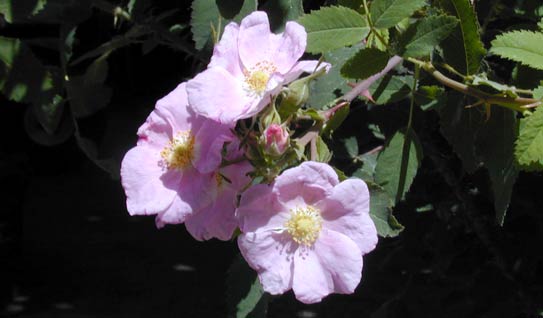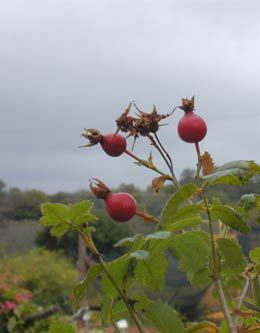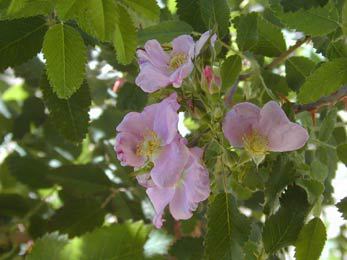California wild rose – Rosa californica
A Rose is A Rose

In 1906, the language employed by author Mary Elizabeth Parsons (The Wild Flowers of California) was, shall we say, a bit more “flowery?”
“The wild rose is one of the few flowers that blooms cheerfully through the long summer days, lavishing its beautiful clusters of deliciously fragrant flowers as freely along the dusty roadside as in the more secluded thicket. In autumn it often seems inspired to a special luxuriance of blossoming, and it lingers to greet the asters and mingle its pink flowers and brilliant scarlet hips with their delicate lilacs.”
Will our common wild rose enjoy such admiration today? It should.
Rosa californica is among the prettiest, most carefree plants you can use in the native plant garden. It is best in medium to large spaces where it will clump and spread with underground runners. The plant blooms profusely at the top of its stems, about chest height, so that the numerous fine, single rose pink flowers can be seen and appreciated. It has a very long (spring through summer) blooming season.
 An established clump is virtually impenetrable making it a good choice for a screen or barrier planting. It is a classic “rose” with compound leaves, thorns, flowers on long stems and lovely fragrance. The rose hips (seed bearing fruit) are bright red and rich in medicinal and curative properties.
An established clump is virtually impenetrable making it a good choice for a screen or barrier planting. It is a classic “rose” with compound leaves, thorns, flowers on long stems and lovely fragrance. The rose hips (seed bearing fruit) are bright red and rich in medicinal and curative properties.
Wild rose in the landscape could be considered a “keystone” species, that is, a plant that cements a relationship between the other plants, the animals, birds and insects that inhabit the area. The flowers support many pollinator species. It provides excellent nesting habitat for songbirds. It will attract butterflies. Its long blooming season will be a compliment to all the plants nearby. After the bloom season, wild rose hips persist on the plant and are an important food source for birds and mammals.
Wild rose will grow in a wide range of soil types and will do quite well in heavy soils that are hard on some other native plants. It would make an excellent choice for retrofitting a landscape; replacing some tired old standbys like Escallonia, Pittosporum or Cotoneaster on a big slope. It will get by on much less irrigation than the amount applied to most slopes and common areas, but will appreciate occasional summer water from the existing sprinkler system.
It is relatively pest and disease free, though rust might appear on the leaves if the plant is subject to overhead irrigation, poor air circulation and humid conditions in the shade. Insect pests are never a problem with such a hardy plant and with so many “beneficials” around. Wild rose will grow best without pruning, but shaping or thinning will tidy it up. Old plants can be rejuvenated with severe pruning to encourage new growth from the base. Any organic, all-purpose plant food will keep it healthy, flowering, and attractive all year.
Good companion plants for habitat value and beauty might include:
Western Sycamore , Platanus racemosa
Toyon, Heteromeles arbutifolia
Coffeeberry, Rhamnus californica
California Wild Lilac, Ceanothus (e.g.)‘Joyce Coulter,’
Matilija Poppy, Romneya ‘White Cloud’
White Sage, Salvia apiana
Deergrass, Muhlenbergia rigens
Red Monkeyflower, Mimulus aurantiacus puniceus
Coyote Mint, Monardella spp.
Prickly-pear, Opuntia littoralis
Coyote Brush, Baccharis sp.
 …and of course those fall blooming lavender asters Ms. Parsons mentioned, such as Lessingia species or Aster chiloensis. There are too many possible uses for wild rose, and by far too many possible companion plants for us to list here.
…and of course those fall blooming lavender asters Ms. Parsons mentioned, such as Lessingia species or Aster chiloensis. There are too many possible uses for wild rose, and by far too many possible companion plants for us to list here.
Wild rose grows naturally in more or less moist areas and stream banks, below 5000’ elevation, in virtually every habitat type of California. Having proved itself so well in wild places is a great choice for use in the human landscape.
You can bring this rose in from out of the wild, but don’t try to make it too tame. Fact is we need more “wild” plants and “wild” landscapes around us. A good plant to start with is California’s common wild rose.
Featured Photo Credit: Tree of Life Nursery ©